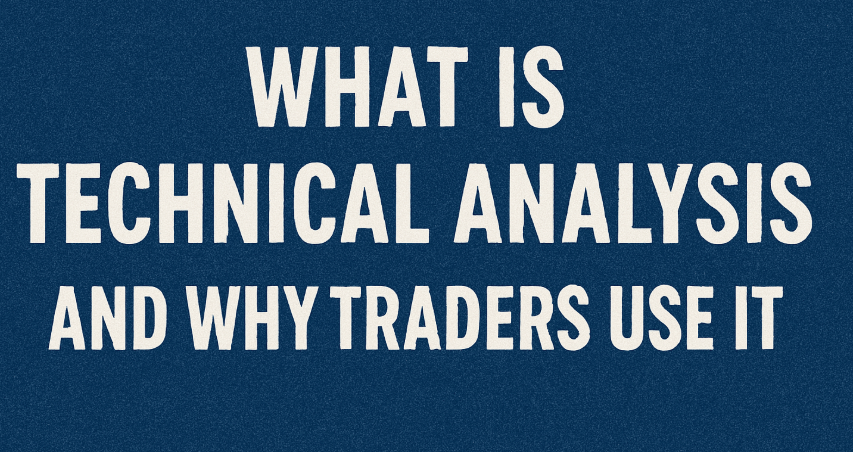- Live Life Grow Wealth
- Posts
- 💹 Series 8 Day 1 – What Is Technical Analysis and Why Traders Use It
💹 Series 8 Day 1 – What Is Technical Analysis and Why Traders Use It

Today’s Headline
💹 Series 8: Mastering Technical Analysis
Day 1 – What Is Technical Analysis and Why Traders Use It
When I first started investing, staring at stock charts felt like trying to read a foreign language.
Lines went up, lines went down, candles looked like little rockets, and everyone around me seemed to “understand” something that I didn’t.
I used to ask myself, How do these traders know when to buy or sell?
And over time, I learned something important: they don’t guess… they read charts.
This is what technical analysis is all about.
It’s not magic.
It’s not predicting the future.
It’s simply studying how price moves, so you can make higher-probability decisions.
And today, I want to open this world for you in the simplest possible way.
Smart marketers know the value of a great newsletter, but writing it? That’s a job for someone else. With Orbit Marketing, you get a revenue-driving newsletter sent to your prospects every week - without having to lift a finger.
There’s never been a better time to tap into the potential of your email list.
📌 What Is Technical Analysis, Really?
Technical analysis (TA) is the practice of analyzing price charts to understand market behavior.
Instead of looking at company fundamentals like revenue or debt, TA focuses on:
Prices
Volumes
Trends
Patterns
Momentum
Think of it like reading body language.
When someone folds their arms, avoids eye contact, or takes a step back—you can “guess” what they might be feeling.
Charts do the same thing.
They reveal what buyers and sellers are doing behind the scenes.
And once you understand this behaviour, you don’t just buy blindly.
You buy when the odds tilt in your favour.
📌 Why Do Traders Use Technical Analysis?
There are 3 big reasons traders rely on TA every single day.
1. Markets Are Driven by Human Emotions
Fear.
Greed.
FOMO.
Hope.
Every big move in the market is powered by human emotions.
And emotions leave fingerprints on a chart.
For example:
Panic selling creates sharp drops
Greedy buying creates strong rallies
Indecision forms sideways movements
Technical analysis helps you recognise these emotions, so you don’t fall into the same traps.
2. Price Moves in Trends
Price rarely moves in a straight line.
It moves in waves—up, down, up, down—like the tide.
TA helps you identify:
Uptrends – when buyers are in control
Downtrends – when sellers dominate
Sideways trends – when no one is in charge
If you know what trend you’re in, you instantly have a better idea of what to do next.
You don’t swim against the current.
You follow it.
3. Patterns Tend to Repeat Themselves
History doesn’t repeat exactly, but it often rhymes.
Traders noticed that certain patterns appear again and again:
Double top
Double bottom
Head and shoulders
Cup and handle
Ascending triangle
These patterns are not random.
They reflect how people behave during fear or excitement.
When you learn to recognise them, you get early “signals” before the crowd reacts.
📈 Candlesticks – The Foundation of Every Chart
Before you learn any pattern, you must know candlesticks.
They are simple, but powerful.
A single candlestick tells you:
Opening price
Closing price
Highest price
Lowest price
In one look, you know whether buyers or sellers won that battle.
You don’t need to memorise every candlestick type.
Just understand the basics:
Green candle = buyers pushed price up
Red candle = sellers pushed price down
Long wick = strong rejection happened
Small body = indecision
Once you understand these details, the chart becomes alive.
"Boost your investment strategy by unlocking the power of CTV advertising with Roku Ads Manager—learn how to maximize returns this holiday season. Click here to explore!"
Find your customers on Roku this Black Friday
As with any digital ad campaign, the important thing is to reach streaming audiences who will convert. To that end, Roku’s self-service Ads Manager stands ready with powerful segmentation and targeting options. After all, you know your customers, and we know our streaming audience.
Worried it’s too late to spin up new Black Friday creative? With Roku Ads Manager, you can easily import and augment existing creative assets from your social channels. We also have AI-assisted upscaling, so every ad is primed for CTV.
Once you’ve done this, then you can easily set up A/B tests to flight different creative variants and Black Friday offers. If you’re a Shopify brand, you can even run shoppable ads directly on-screen so viewers can purchase with just a click of their Roku remote.
Bonus: we’re gifting you $5K in ad credits when you spend your first $5K on Roku Ads Manager. Just sign up and use code GET5K. Terms apply.
📈 The Three Pillars of Technical Analysis
To truly master TA, you only need to learn three main pillars.
These three things form the base of every trader’s decision-making process.
1. Trend Analysis
This answers the most basic—and most important—question:
Is the market going up, down, or sideways?
If you get this wrong, almost everything else falls apart.
Trend determines your direction.
There are a few simple tools to identify trends:
Moving averages (MA)
Trendlines
Higher highs and higher lows (for uptrends)
Lower highs and lower lows (for downtrends)
If you understand trends, you already know 50% of technical analysis.
2. Support & Resistance
Support is a price level where buyers tend to step in.
Resistance is a price level where sellers usually appear.
Think of support like a floor.
Think of resistance like a ceiling.
Price often:
Bounces off support
Gets rejected at resistance
Breaks out when momentum is strong
Once you can identify these levels, your timing improves dramatically.
You enter closer to lows and avoid buying near temporary highs.
3. Indicators
Indicators are mathematical tools based on price or volume.
They help you “see” what your eyes might miss.
Some popular ones include:
RSI (Relative Strength Index) – shows overbought/oversold zones
MACD – shows momentum shifts
Moving Averages – show trend direction
Volume – shows participation strength
You don’t need to learn all indicators.
In fact, most successful traders use only 2–3.
The key is simplicity.
📚 Why Technical Analysis Works (Even If It Sounds Too Simple)
Many new investors ask me this:
“If everyone knows patterns, shouldn’t they stop working?”
Actually, no.
Patterns work because they come from human behaviour.
And human behaviour rarely changes.
People get greedy at the top.
People panic at the bottom.
People hesitate in the middle.
TA doesn’t predict the future.
It reveals the present.
And the present gives you clues on what’s more likely to happen next.
🌊 Technical Analysis vs Fundamental Analysis
You don’t have to choose one.
Both matter.
Fundamental analysis answers:
Is this company strong?
Is this stock worth owning long-term?
Is the business profitable?
Technical analysis answers:
When should I buy?
When should I sell?
Where is the best entry?
Where should I put my stop loss?
Fundamentals tell you what to buy.
Technical analysis tells you when to buy.
Together, they make you a more complete investor.
🧠 Technical Analysis Helps You Avoid Emotional Mistakes
Most traders lose money because they react emotionally:
They chase when price pumps
They panic when price drops
They hesitate and miss opportunities
Technical analysis gives you a plan.
A plan removes emotion.
When you can trust your chart-reading skills, you act with confidence instead of fear.
📉 Common Mistakes Beginners Make
Let me share the biggest mistakes I see beginners making when they first use TA:
❌ 1. Using too many indicators
More indicators ≠ better results.
It only causes confusion.
❌ 2. Looking for “perfect” signals
There’s no perfect signal.
TA is about probability, never certainty.
❌ 3. Ignoring the overall trend
The trend is your friend… until it ends.
But beginners often fight the trend.
❌ 4. Trading without a plan
TA only works if you have:
Entry strategy
Exit plan
Stop-loss rule
❌ 5. Switching strategies too fast
Stick to one method long enough to understand it.
Don’t jump from trend trading → scalping → indicator trading every week.
📈 A Simple 3-Step Framework to Start Using Technical Analysis Today
Here’s a simple method I use that you can apply immediately.
Step 1: Identify the Trend
Ask:
Is price making higher highs & higher lows? → Uptrend
Is price making lower highs & lower lows? → Downtrend
Is price moving sideways? → Consolidation
Don’t do anything until you answer this.
Step 2: Find Support & Resistance
Mark out zones where:
Price previously reversed
Price consolidated
Price struggled to break through
These are key decision areas.
Step 3: Wait for Confirmation
Look for signals like:
Breakouts
Rejections
Candlestick patterns
Volume spikes
You don’t buy just because price hits support.
You buy when support holds.
Confirmation = higher probability.
🔥 Why Day 1 Is So Important
Technical analysis is a big topic.
It has many tools, patterns, and strategies.
But today’s lesson is the foundation.
If you understand this foundation well, everything else becomes easier.
You’ll start to see charts differently.
You’ll begin to understand what traders are thinking.
And slowly, you’ll build the confidence to make decisions based on logic, not emotions.
This is the first step toward becoming a smarter, more skilled investor.
Final Takeaways
If you take away only one thing from today’s lesson, let it be this:
👉 Technical analysis helps you make decisions based on price, not emotions.
It doesn’t guarantee profits.
But it gives you clarity.
And clarity is priceless in the chaotic world of investing.
This week, we’re going deeper—into charts, candlesticks, patterns, indicators, and real setups you can start recognising on your own.
By the end of this 7-day series, you’ll be miles ahead of where you started.
🚀 Call to Action
If you enjoyed today’s lesson and want to master technical analysis step-by-step, stay tuned for Day 2 tomorrow.
Make sure you don’t miss it.
And if you know someone who keeps “guessing” the market, share this mini-lesson with them.
Help them learn how the chart actually works.
Let’s grow smarter together.
Let’s grow wealthier together.
[Live Life Grow Wealth]
🎓 Free Masterclasses to Unlock Your Investment Potential
Take your money skills to the next level with expert-led workshops designed to help you grow smarter and faster.
Recommendations Section
“Peek into smart money moves — when big players act, you’re in the loop.”
|
Learn simple, proven ways to grow your money — straight from real investors who walk the talk.
|
“Hone your investing edge in just 5 minutes — smart, snappy insights to power your portfolio growth.”
|
“Stay ahead with one expert-picked stock monthly — clear, no jargon, built for growth.”
DISCLAIMER
I make no representations, warranties, or guarantees, whether expressed or implied, that the content provided is accurate, complete, or up-to-date. Past performance is not indicative nor a guarantee of future returns.
I am an individual content creator and not regulated or licensed by the Monetary Authority of Singapore (MAS) as I do not provide investment services.
All forms of investments carry risks, including the risk of losing your entire invested amount. Such activities may not be suitable for everyone. You are strongly encouraged to seek advice from a professional financial advisor if you have any doubts or concerns.








